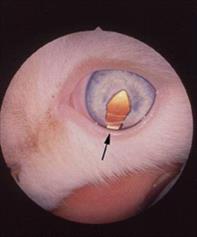An iris coloboma

Photo by Dr. Rhea Morgan
The iris is the part of the eye that’s colored. In dogs, the iris is usually brown or blue. In cats, it can be brown, blue, green, and gold (yellow). The pupil, which is the black hole in the center of the iris, controls how much light gets into the eye to the retina.
Coloboma means a thinning or a hole in the eye structure. In this context, it is an indication of how thin the iris is. The animal is born with the coloboma; it’s an area of the iris that never formed properly. Large holes allow more light to enter the eye through the pupil, resulting in squinting. The coloboma can be mild or severe. In severe cases, there is a sort of notch in the margins of the pupil.
The iris coloboma, which is relatively uncommon, does not affect vision, and it does not progress to anything else. Unless your affected pet herds sheep or cattle, this sensitivity to light is not usually a big problem. Nothing can be done to treat it, although it’s possible to buy dog goggles (Doggles®) that function as sunglasses, and reduce the squinting. (Most cats would rather not wear such goggles.)
Most congenital (born with) iris colobomas are genetic. Affected dogs or cats should not be bred. It is one of the things dogs are screened for during a Companion Animal Eye Registry (CAER) exam. When eye exams are done, the irises will be examined both before and after the eyes are dilated, as some small colobomas might not be seen after dilation. At the present time, cat registries do not screen for this. If you are getting a purebred puppy from a breed known to have iris colobomas, ask the breeder for a CERF rating from each of the parents. It is seen most commonly in Australian Shepherds, but other breeds can have it also. Iris colobomas are easiest to see in light colored irises but may occur in any color of iris.
Although the coloboma itself is not a real problem, other problems associated with it (cataracts, lens colobomas, retinal colobomas, etc.) can cause vision problems. Some of these problems can be treated. The coloboma alone will not cause health problems, but it’s best to keep an affected animal with a severe case out of bright sunlight.